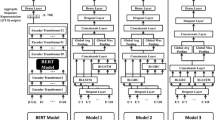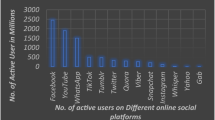Abstract
The various social media platforms are used for easy access of information from the distinctive field that might constitute an offensive discussion. Therefore, existing studies are examined to reduce offensive harassment cases online. The spread of hate speech is growing with the ubiquity and anonymity through the means of social media for many years. Thus, the increase in demand showed an automated model for the detection of hate speech. The existing models utilized deep learning models failed to analyze the syntax and grammar or even modify original data’s meaning due to its complex patterns. Therefore, the present research work utilizes an Activation Function known as Soft-plus in Bidirectional Long Short Term Memory (Bi-LSTM) models for hate speech detection which helps the network to learn complex patterns in the data. The proposed Soft-plus Bi-LSTM learned the c complex patterns present in the network data and the activation function made an end decision that should be fired out into the next neuron. The classification results showed that the proposed Soft-plus Bi-LSTM classified the reviews as abusive or non-abusive speech. The results obtained better precision values of 60.09% when compared to the existing models Auto-Encoder and Multi-task learning model showed a precision of 53.9% and 55.7% respectively.






Similar content being viewed by others
Data Availability
The datasets generated during and/or analyzed during the current study are available in the [OLID, SOLID] repository,
References
Akhter MP, Jiangbin Z, Naqvi IR, Abdelmajeed M, Sadiq MT (2020) Automatic Detection of Offensive Language for Urdu and Roman Urdu. IEEE Access 8:91213–91226. DOI: https://doi.org/10.1109/ACCESS.2020.2994950
Beddiar DR, Jahan MS, Oussalah M (2021) Data expansion using back translation and paraphrasing for hate speech detection. Online Social Networks and Media 24:100153. https://doi.org/10.1016/j.osnem.2021.100153
El-Alami FZ, El Alaoui SO, Nahnahi NE (2021) A multilingual offensive language detection method based on transfer learning from transformer fine-tuning model.Journal of King Saud University-Computer and Information Sciences
Ghanghor N, Krishnamurthy P, Thavareesan S, Priyadharshini R, Chakravarthi BR (2021) IIITK@ DravidianLangTech-EACL2021: Offensive Language Identification and Meme Classification in Tamil, Malayalam and Kannada. In Proceedings of the First Workshop on Speech and Language Technologies for Dravidian Languages, Association for Computational Linguistics, Kyiv, 222–229
Hande A, Priyadharshini R, Chakravarthi BR (2020) KanCMD: Kannada CodeMixed Dataset for Sentiment Analysis and Offensive Language Detection. In Proceedings of the Third Workshop on Computational Modeling of People’s Opinions, Personality, and Emotion’s in Social Media, Barcelona, Spain (Online), Association for Computational Linguistics [publisher], 54–63
Isaksen V, Gambäck B (2020) Using Transfer-based Language Models to Detect Hateful and Offensive Language Online. In [Online] Proceedings of the Fourth Workshop on Online Abuse and Harms, Association for Computational Linguistics, 16–27. DOI: https://doi.org/10.18653/v1/2020.alw-1.3
Kapil P, Ekbal A (2020) A deep neural network based multi-task learning approach to hate speech detection. Knowl Based Syst 210:106458. https://doi.org/10.1016/j.knosys.2020.106458
Liu J, Yang Y, Fan X, Ren G, Yang L, Ning Q (2022) Offensive-Language Detection on Multi-Semantic Fusion Based on Data Augmentation. Applied System Innovation, 5(1), p.9
Mandl T, Modha S, Kumar MA, Chakravarthi BR (2020) Overview of the HASOC Track at FIRE 2020: Hate Speech and Offensive Language Identification in Tamil, Malayalam, Hindi, English and German. In Forum for Information Retrieval Evaluation, Virtual event hosted by IDRBT, 16th – 20th December, Hyderabad, 29–32. https://doi.org/10.1145/3441501.3441517
Mossie Z, Wang JH (2020) Vulnerable community identification using hate speech detection on social media. Inf Process Manag 57(3):102087. https://doi.org/10.1016/j.ipm.2019.102087
Pathak AR, Pandey M, Rautaray S (2021) Topic-level sentiment analysis of social media data using deep learning. Appl Soft Comput 108:107440. https://doi.org/10.1016/j.asoc.2021.107440
Ranasinghe T, Zampieri M (2021) An Evaluation of Multilingual Offensive Language Identification Methods for the Languages of India. Information 12(8):306. https://doi.org/10.3390/info12080306
Ranasinghe T, Zampieri M, Hettiarachchi H (2019) BRUMS at HASOC 2019: Deep Learning Models for Multilingual Hate Speech and Offensive Language Identification. In FIRE 2019 - Forum for Information Retrieval Evaluation (Working Notes), 12–15 December 2019, Kolkata, India, 199–207
Rawat C, Sarkar A, Singh S, Alvarado R, Rasberry L (2019) Automatic Detection of Online Abuse and Analysis of Problematic Users in Wikipedia. In 2019 Systems and Information Engineering Design Symposium (SIEDS), IEEE, Charlottesville, VA, USA, 1–6. DOI: https://doi.org/10.1109/SIEDS.2019.8735592
Sharma M, Kandasamy I, Kandasamy V (2021) Deep Learning for predicting neutralities in Offensive Language Identification Dataset. Expert Syst Appl 185:115458. https://doi.org/10.1016/j.eswa.2021.115458
Vashishtha S, Susan S (2019) Fuzzy rule based unsupervised sentiment analysis from social media posts. Expert Syst Appl 138:112834. https://doi.org/10.1016/j.eswa.2019.112834
Zhang K, Zhu Y, Zhang W, Zhang W, Zhu Y (2020) Transfer Correlation Between Textual Content to Images for Sentiment Analysis. IEEE Access 8:35276–35289. DOI: https://doi.org/10.1109/ACCESS.2020.2975036
Funding
This research received no external funding.
Author information
Authors and Affiliations
Corresponding author
Ethics declarations
Conflict of interest
The authors declare that they have no conflict of interest.
Additional information
Publisher’s Note
Springer Nature remains neutral with regard to jurisdictional claims in published maps and institutional affiliations.
Rights and permissions
Springer Nature or its licensor holds exclusive rights to this article under a publishing agreement with the author(s) or other rightsholder(s); author self-archiving of the accepted manuscript version of this article is solely governed by the terms of such publishing agreement and applicable law.
About this article
Cite this article
Kothuru, S., Santhanavijayan, A. Automatic hate speech detection using aspect based feature extraction and Bi-LSTM model. Int J Syst Assur Eng Manag 13, 2934–2943 (2022). https://doi.org/10.1007/s13198-022-01763-6
Received:
Revised:
Accepted:
Published:
Issue Date:
DOI: https://doi.org/10.1007/s13198-022-01763-6




